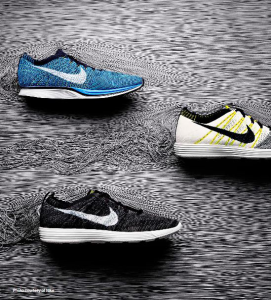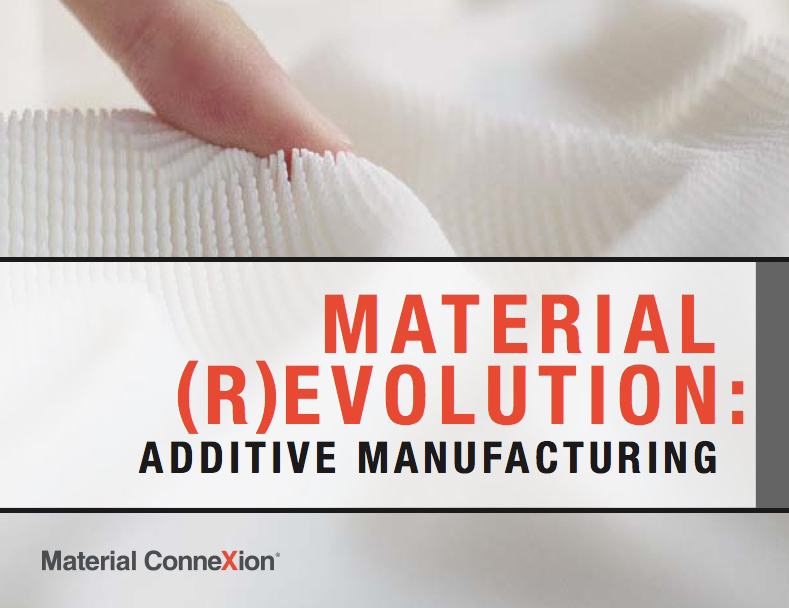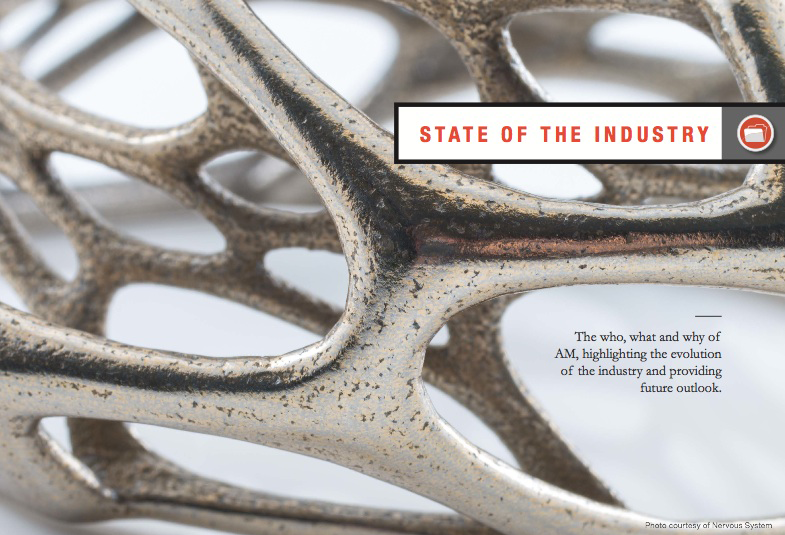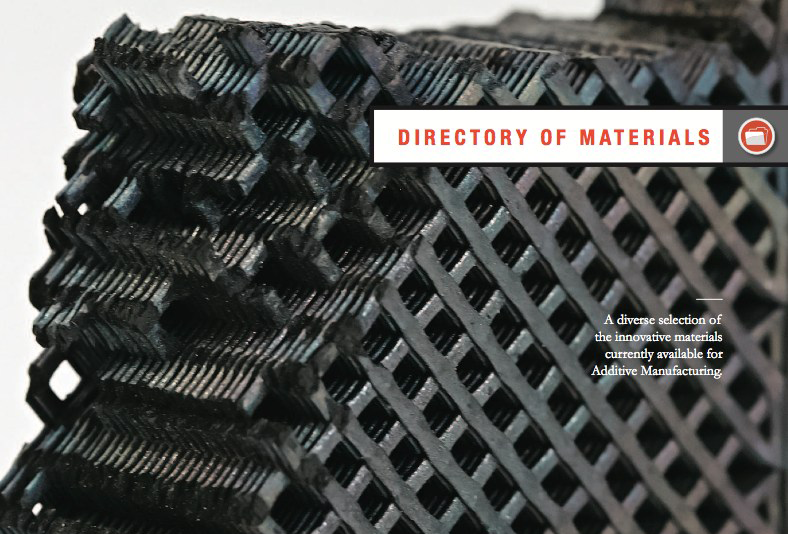Most of us think of libraries as repositories of traditional books (ink on bound paper) and their digital analogs — information content that is displayed on screens. Material ConneXion Inc. (MCX) is a company with a mission to identify, organize and present the industrial and commercial materials of our built and manufactured world to those who would create the next “must-have” products. As our 3D printing universe is booming, MCX has now responded with “Material (R)evolution: Additive Manufacturing,” an extensive report on the rapidly evolving materials that literally feed 3D printing and digital fabrication.
3D printing is all about turning thoughts into things. The physical substances that make up those “things” are a key element in the additive manufacturing process. In February, Hugh Evans, VP Corporate Development & Ventures at 3D Systems Corporation, commented that we are “riding a materials-science revolution” and that 3DPers “now had over 200 certified materials” from which to build their additively manufactured products. At the same time, Mr. Evans remarked that the latest suites of software driving the newest 3D printers were beginning to deliver “10X speed increases.”
In August, Gonzalo Martinez, Director of Strategic Research in the office of the CTO at Autodesk, stated on 3D Printing Podcast that, with Autodesk’s 3D printing initiatives, “…we are allowing people to experiment with different materials. Because the game-changer in this industry — besides the capability of the 3D printer — is the quality of the material that can come from that device…There is a need for [improvements] in the materials science…to speed up the process and make it very, very affordable are things that we [at Autodesk] are trying to do…we want to disrupt…the [3D printing] industry.”
In effective uses of 3D printing, speed of production is one of the main issues with which our 30-year-old — yet “new” to most — industry is contending. Especially in the consumer marketplace. In the last two or three years, over 200 “desktop” 3D printer manufacturers have joined the contest to gain viable market share. (Interestingly enough — as of last month — 54 of these were “underwritten” by the irrepressible crowd-funders of Brooklyn’s Kickstarter alone.)
Most players in this new consumer/prosumer market have tried to leverage everything from lowest price points to highest quality, but none — I believe —have been able to differentiate their offerings based on higher effective production-throughputs.
So, 3D printer users are still forced to “braid” the three dissimilar cords of machine design, software intelligence and material composition. And, as we see above, the machine makers and the software developers both point to materials science as the current key to production speed — AND customer-delighting product innovation and solution provisioning.
Now, MCX — a unique provider of materials knowledge for designers and makers — has focused on the material needs of 3D printing. MCX calls itself “the world’s largest library of innovative, advanced and sustainable materials.” And, it does — quite literally — present a high-tech repository of thing-making “stuff” to its client/users.
Over 7,500 material samples — and growing at between 30 and 50 new specimens per month — are arrayed and showcased on aisles in a fashion that fuses the sensibilities of a library, museum and trade show. “Patrons” of this “library” can look, touch, play, and learn about the physical and manufacturing qualities of the materials in the Material Connexion “collection.”
To buttress its new “rationalization” of 3D printing materials, ThinkLAB — the consulting division of MCX — has released the first-of-its-kind report for the Additive Manufacturing space. Entitled “Material (R)evolution: Additive Manufacturing” (M{R}:AM), the company — in 100 pages plus — has built on its wide and deep understanding of the literal matter, corporal substance and ineffable flights of stuff that can comprise manufactured goods. This will be the first of a quarterly series of MCX digital reports that explore groundbreaking technologies in materials science and its ancillary disciplines.

MCX continues, “Through case studies, state of the industry overview and future outlook, expert interviews, a curated selection of new materials, visual glossary and a resource directory, each report provides beginners and professionals an inspiration and resource tool to stay ahead of the competition.”
For instance, one of the most useful complex-knowledge presentations in the Additive Manufacturing Report is the “visual glossary.” These diagrammatic depictions of the current, seven-major, 3D printing processes available in the marketplace — plus added-value ancillary information — may be the clearest now to be had. This kind of clarity is just one reason why this direct-order, PDF-formatted Report is worth its cost (US$495.00).
To gain a deeper appreciation of MCX and its innovative offering for our world of 3D printing, I had the opportunity to interview one of the co-authors of M(R):AM. This is Sarah Hoit, Materials Scientist, Material ConneXion and ThinkLAB. Sarah holds a Masters of Science from the College of Textiles, North Carolina State University. (With her background in non-woven textiles, liquid repellency and polymers, perhaps Ms. Hoit will innovate a way to closely mimic woven constructs via 3D printing; this kind of “weaving” is already being done in a fashion — at the micron-level — by Med Sci technologists working to 3D print functional human tissues.) My questions of Sarah are in bold type in the following sections.
Please explain the mission of your organization and how you help accomplish it.
“Material ConneXion helps companies leverage material innovation to create better products and experiences. Through research, cross-industry analysis and strategic planning, we support designers and companies across diverse fields to incorporate innovative, advanced and sustainable materials into their projects and products. Based on the belief that ‘Every Idea Has a Material Solution,’ [the MCX tagline], Material ConneXion offers diverse membership packages, [mimicking the for-profilt ‘lending libraries’ of the 19th C.], for individual, corporate and academic institutions.”
Further, Ms. Hoit explained that MCX sees itself — first and foremost — as a “consumer-facing research resource” with “a physical, ‘Please Touch’ library…where designers can come” in person for hands-on, material investigations and solutions brainstorming with staff.
How and when did MCX get started?
“[Our Founder] George M. Beylerian [long involved in creating, marketing and retailing design-related products for the consumer and the contract markets] started importing plastic furniture [from Italy]. [As a result, he] then went to work for Steelcase in design. Steelcase museum events caused him to start thinking differently about materials. [After 10 years, he] left Steelcase and started Material ConneXion as a resource for designers…MCX was founded in 1997.
“George thought architects and designers would be their first and most important clients. Instead, their first clients were Victoria’s Secret and Mattel!” [Ah, unintended consequences: sex and toys… —LG.]
I see you wear “two hats”: including Materials Scientist for MCX’s ThinkLAB…
“ThinkLAB — the consulting division of Material ConneXion — provides curated assistance to companies that are looking for new ways to incorporate materials and innovative design into their projects.”
Sarah went on to describe how she might — working with a client — “consult for design and branding people and then [their] engineers,” ultimately acting as a “bridge between engineers and designers” — who employ “two different languages.” She helps build an intra-company connection — that metaphorical “bridge” — and then “stands in the middle and translates.”
What is your business model (how do you make money)?
“All members pay an annual fee that grants them access to the global network of MCX libraries — 25 staff here in New York City and 100 around the world at 8 licensees: first, and probably still most important, is in Milan — and comprehensive online database. We provide monthly updates on new materials that have been entered into the library and special programs that spark creative materials thinking, including Active Matter, Spotlight and library leasing programs.”
How does MCX interact with its far-flung licensees?
“Licensees do a lot of good work bringing new materials to the attention of the main office. They have their own local libraries. Bangkok deals with a lot of natural materials, like bamboo. Milan is involved in leather and fashion materials.
How are you addressing 3DP materials and what products/services are you offering around them now?
“Material ConneXion has a rich history in 3D printing and its compatible materials — we added our first 3D-printable material to the library in 1997. We recently published the Material (R)evolution report on additive manufacturing because we felt it was an important topic to cover at this time given the recent deluge of content being created on the topic. While there is a slew of information available, we felt there was a lack of basic grounding and understanding, which makes it difficult to navigate for people not intimately engaged in the field.
“Our report offers information about primary machine technologies, case studies, the state of the industry, new materials and future outlook. In conjunction with our report, I will be giving a complimentary webinar [“Make 3D Printing Work for You” — Wednesday, 5 November, 12 PM] on integrating this technology into businesses to help business owners determine whether or not it’s a good fit for their specific needs.”
Three important industries in New York City are fashion, food and furniture. What are the latest 3D printable materials available for these industries?
“While there are a host of new materials, I believe it is the customization of machinery that will bring these industries to life in a meaningful way for consumers.

“There is an abundance of talk about 3D-printed ‘fabric’ and the difficulty in achieving it. While there is work being done in this space, utilizing plastics to form flexible structures, the machinery for the additive manufacturing of textiles has existed since the 1970’s. This process, termed 3D knitting, utilizes the same textile yarns as the garments we wear today, creating complex shapes and fully formed garments straight out of the machine, without cutting and sewing.
“Food is a fascinating ‘printing’ challenge because, to state the obvious, it needs to be made of edible food. Currently, extrusion and powder bed processes are creating a host of food types, from fish and chips to pizza and complex sugar and chocolate sculptures. What’s really interesting here is the secondary processing needed to complete the food, cook the meat and bake the dough.
“Furniture is, in many ways, a discussion of scale—especially as we’re beginning to see 3D-printing processes leave the ‘box,’ which limits build volume. Now we’re seeing that there is no limit to the size of an object being created.”
Direct metal and end-use printing are major vectors in 3DP. From MCX’s point of view, what’s the latest in “direct metal” 3DP materials?
“Metal is appealing because it can offer what we as the consumer see as a “finished” product and Additive Manufacturing can offer improved physical properties in a part over those of some traditional processing techniques. Electron beam melting is providing the temperatures needed for direct metal fabrication.
“Another interesting use of electron beams is the Free Form Fabrication technique being developed at NASA’s Langley research center to produce near-net-shaped parts in a layering process using wire-feed stock in a vacuum chamber.”
And, as a Materials Scientist and a “Substance Librarian,” what else do you see in our 3DP future?
“We see new developments every day, both in the lab and in commercial products. The most interesting for me is the development of [3D] printers that accept materials in standard commodity formats—with that in mind, EVERY material is a ‘3D-printable material!’





